Fix Readme
Abstract
This document contains guidance for installation of the IBM InfoSphere Information Server 11.7.1.3 Service Pack 4 upgrade package available on IBM Fix Central.
Content
Table of Contents
1) Introduction
2) Using a password or passwordless SSH for installation
3) Downloads and pre-Upgrade steps
4) Installation of 11.7.1.3 Service Pack 4
4.1. Instructions for upgrading Information Server in GUI mode of the Update Installer
4.2. Instructions for upgrading Information Server in Console mode of the Update Installer
5) Post upgrade actions
1) Introduction
The IBM InfoSphere Information Server 11.7.1.3 Service Pack 4 ispkg image is available for upgrading of Information Server version 11.7.1.3 installations. The steps for installing Information Server 11.7.1.3 Service Pack 4 depend on whether the Microservices tier is installed.
Requirements for installing 11.7.1.3 Service Pack 4:
- You must install Information Server version 11.7.1.3.
- If you have a Microservices tier, it must be at version 11.7.1.3, and all pods must be up and running.
Depending on your installation environment and whether you installed the original or latest version of 11.7.1.3, more steps might be required before you install 11.7.1.3 Service Pack 4.
Check whether your installation environment matches the Environment section in technote.
If it does, you can determine whether you need to do these steps in one of two ways:
- Examine the name of the file that you downloaded for installation of 11.7.1.3:
- Original version: fixpack_FP3_IS1171_linux64_11710-11712.tar.gz
- Latest version: fixpack_FP3_Respin1_IS1171_linux64_11710-11712.tar.gz
- Examine the description in the 11.7.1.3 PatchManifest.xml file installed on your system (about line 6 in the file):
- Original version: <Description description="Information Server 11.7.1 FixPack 3 (fixpack.is_11_7_1_3.linux64.b134.211020-2005)"/>
- Latest version: <Description description="Information Server 11.7.1 FixPack 3 (fixpack.is_11_7_1_3.linux64.b135.211201-0526)"/>
2) Using a password or passwordless SSH for installation
During the installation of Information Server 11.7.1.3 Service Pack 4, you can continue to use your current setup; no changes are needed to facilitate the installation.
However, you might want to take advantage of newly added features in the installer:
See the next section for details.
2.2) Installation modes available while upgrading the Microservices tier
You have four installation modes to choose from, during upgrade of the Microservices tier:
In this case, you do not have to set up passwordless SSH from the Information Server host to the master node.
However, for a multiple nodes environment, you must set up passwordless SSH for the root user from the master node to the worker nodes.
The specified nonroot user must have sudo privilege with NOPASSWD enabled.
In this case, you do not have to set up passwordless SSH from the user running the installation on the Information Server host to the master node.
For a multiple nodes environment:
ii. You must set up passwordless SSH for the specified nonroot user from the master node to the worker nodes.
You must set up passwordless SSH from the user running the installation on the Information Server host to the master node.
For a multiple nodes environment, passwordless SSH must also be set up for the root user from the master node to the worker nodes.
The specified nonroot user must have sudo privilege with NOPASSWD enabled.
You must set up passwordless SSH from the user running the installation on the Information Server host to the master node.
For a multiple nodes environment:
i. The specified nonroot user must be set up in the same manner on all nodes.
ii. Passwordless SSH must also be set up for the specified nonroot user from the master node to the worker nodes.
a. If the file /root/.ssh/id_rsa.pub does not exist, create the SSH Keys with the following command:
> ssh-keygen -f /root/.ssh/id_rsa -q -N ""
b. Copy the SSH public key to the Microservices Tier node with the following command:
> ssh-copy-id -i /root/.ssh/id_rsa.pub root@<enterprise search="" node="">
c. Validate the root passwordless SSH connection to the Microservices Tier node with the following command:
> ssh root@<enterprise search="" node=""> hostname
A nonroot user with sudo privileges can be set up for passwordless SSH in the same manner.
3) Downloads and pre-upgrade steps
Update the Update Installer to the latest (11.7.1.105 or later):
3.1.1) On the Information Server host, download the Update Installer from
https://www.ibm.com/support/pages/node/6574447
3.1.2) In the document, Updating IBM InfoSphere Information Server, Version 11.7, and installing additional products, under Version 11.7, click the link installing_fixes_fixpacks_updates117.html.
3.1.3) See section “Installing a new version of the Update Installer before installing an update, fix, or patch” for the steps to extract the new Update Installer and run updateImage.sh.
If you used the default directory for Information Server, the Update Installer is installed in /opt/IBM/InformationServer/Updates/bin.
3.2) Download the 11.7.1.3 Service Pack 4 images
You must download the following images from IBM Fix Central depending on your installation choices.
For more information on locating the images, see the Download document.
3.2.1) On the Information Server host, download, and extract the Information Server 11.7.1.3 Service Pack 4 ispkg image from IBM Fix Central.
For example, servicepack_11.7.1.3_SP4_linux64_11713.tar.gz
Note:
1. Set your umask to 022 before the image is extracted.
2. Unpack the file to get the ispkg and readme files.
3.2.2) On the Microservices tier, download the ISES Image for Information Server 11.7.1.3 Service Pack 4 from IBM Fix Central. Do not extract the file.
For Service Pack 4, servicepack_11.7.1.3_SP4_microservices_11713.tar.gz
$ cd <IIS_INSTALL_LOCATION>/ASBServer/bin
$ ./iisAdmin.sh -set -key com.ibm.iis.ug.installed.version -value 11713
4) Installation of 11.7.1.3 Service Pack 4
Most of the following screen captures are from installing Service Pack 2. The same apply to Service pack 4.4.1) Instructions for upgrading Information Server in GUI mode of the Update Installer
4.1.1) Login to the Information Server host. Change directory to <IS_HOME>/Updates/bin
For example, cd /opt/IBM/InformationServer/Updates/bin
4.1.2) Verify that the Update Installer version is 11.7.1.105 or later:
./installUpdates -version
4.1.3) Initiate the Service Pack install with the following command:
./installUpdates
This command launches the Update Installer in GUI mode.
4.1.4) Provide information as required in each panel to complete the installation.
Click Login.
4.1.5) Review the System requirements, Release Notes, and Planning information.
Click Next.
4.1.6) The Update Installer displays the Information Server installation directory.
Click Next.
4.1.7) If you do not have a Microservices tier, skip forward to step 4.1.8.
Note: Information on adding a Microservices tier to 11.7.1.3 Service Pack 4 can be found in technote 6241456.
4.1.7.1) You can choose whether to upgrade the Microservices tier during the installation of 11.7.1.3 Service Pack 4.
Note the following requirements for upgrade:
1. The Microservices tier must be at version 11.7.1.3.
2. All pods must be up and running.
You can check the status of the pods by running the following command:
kubectl get pods --all-namespaces
4.1.7.2) If you do not want to upgrade the Microservices tier now, check the "Skip patching of Information Server microservices tier" checkbox.
Click Next and skip forward to step 4.1.8.
Information on later upgrading your Microservices tier to 11.7.1.3 Service Pack 4 can be found in technote 6241456.
4.1.7.3) To upgrade the Microservices tier
a. Deselect the "Skip patching of Information Server microservices tier" checkbox.
b. Specify a fully qualified domain name for the Master Node Host.
c. Specify the same User as was used during the initial installation of the Microservices tier.
d. See section 2.2 for more information on "Authenticate with a password".
e. If you specify a nonroot user, in /etc/security/limits.conf, the hard and soft setting of nofile and nproc for the specified user must be 10240.
Also, umask must be set to 022 in ~/.bashrc.
Click Next.
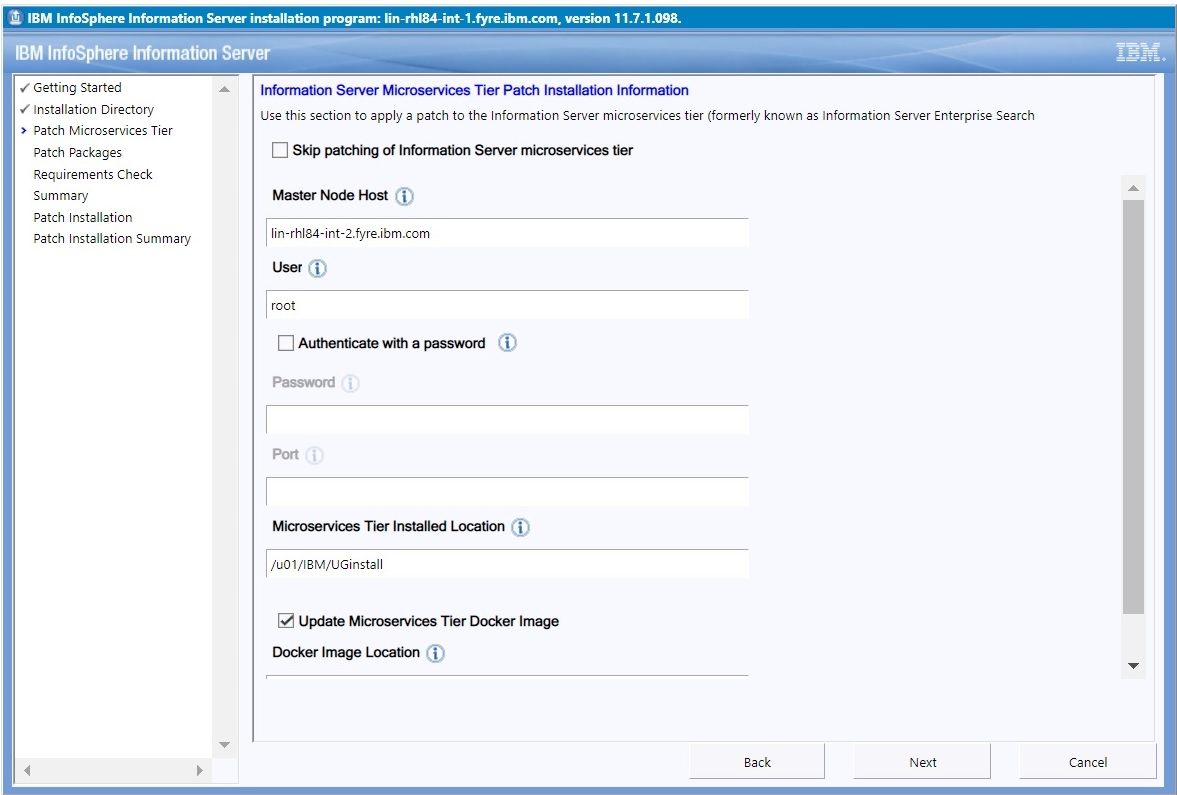
4.1.8) In the list of "Packages to be installed", select the 11.7.1.3 Service Pack 4 ispkg file you downloaded from IBM Fix Central.
Click Next.
4.1.9) If you have a Microservices tier, provide your existing credentials for Kafka and Solr (for example, solruser, solrpwd etc). The Update Installer creates the specified users in Kafka and Solr; they do not have to be an operating system user, Information Server user, or LDAP user.
Later, you can use the specified values for maintenance actions such as accessing the Solr web UI.
Click Next.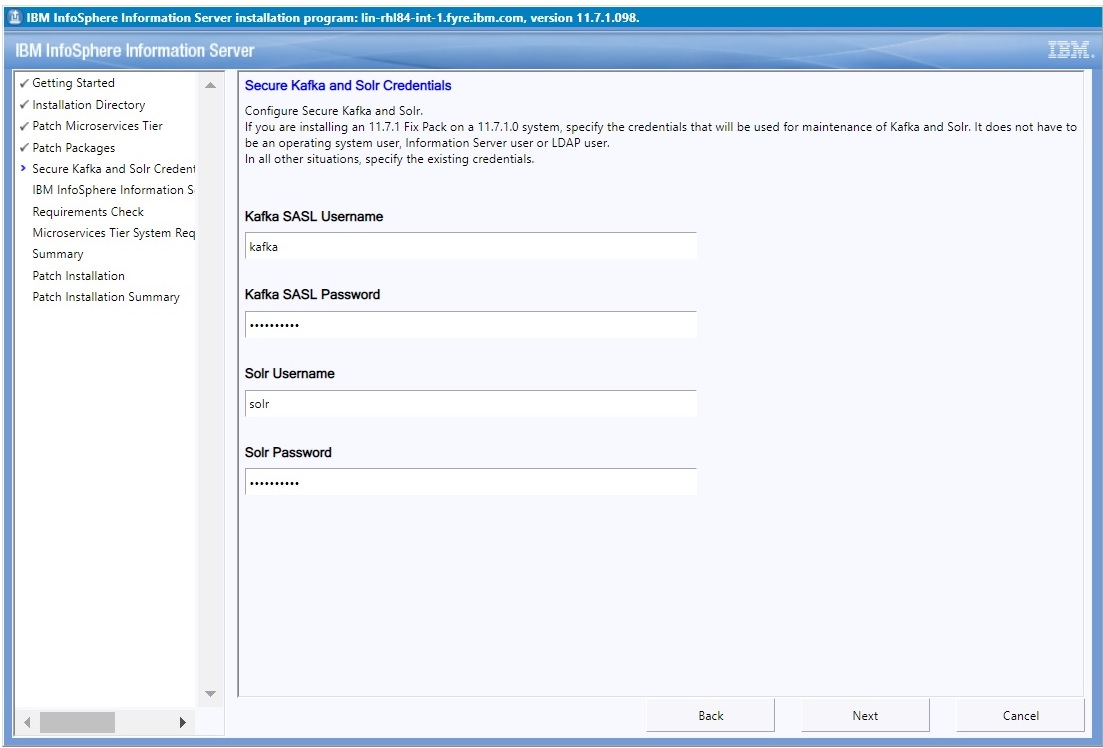
4.1.10) Provide the location of Information Server, the Administrator user name, and password. Accept the certificate and click Next.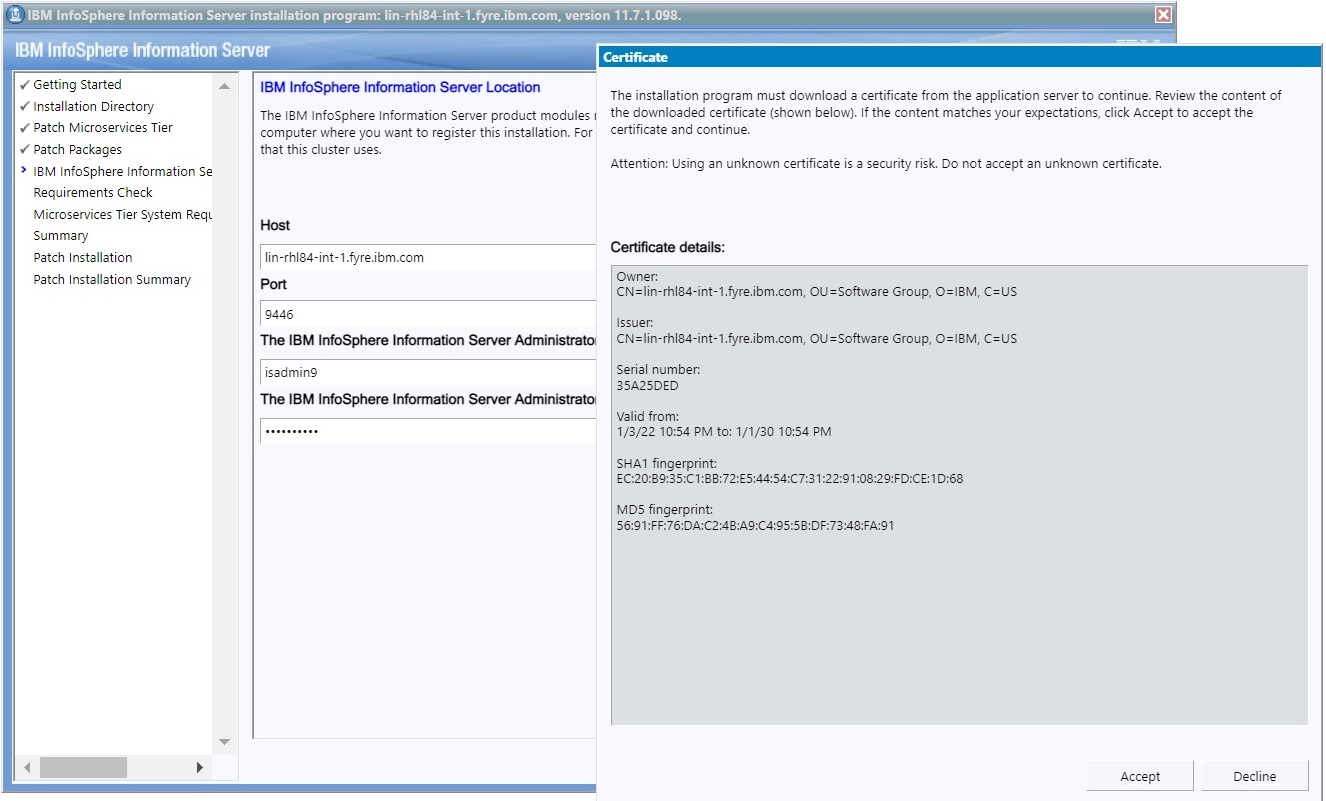
4.1.11) On the System Requirements Check page, confirm that all system requirements passed, and then click Next.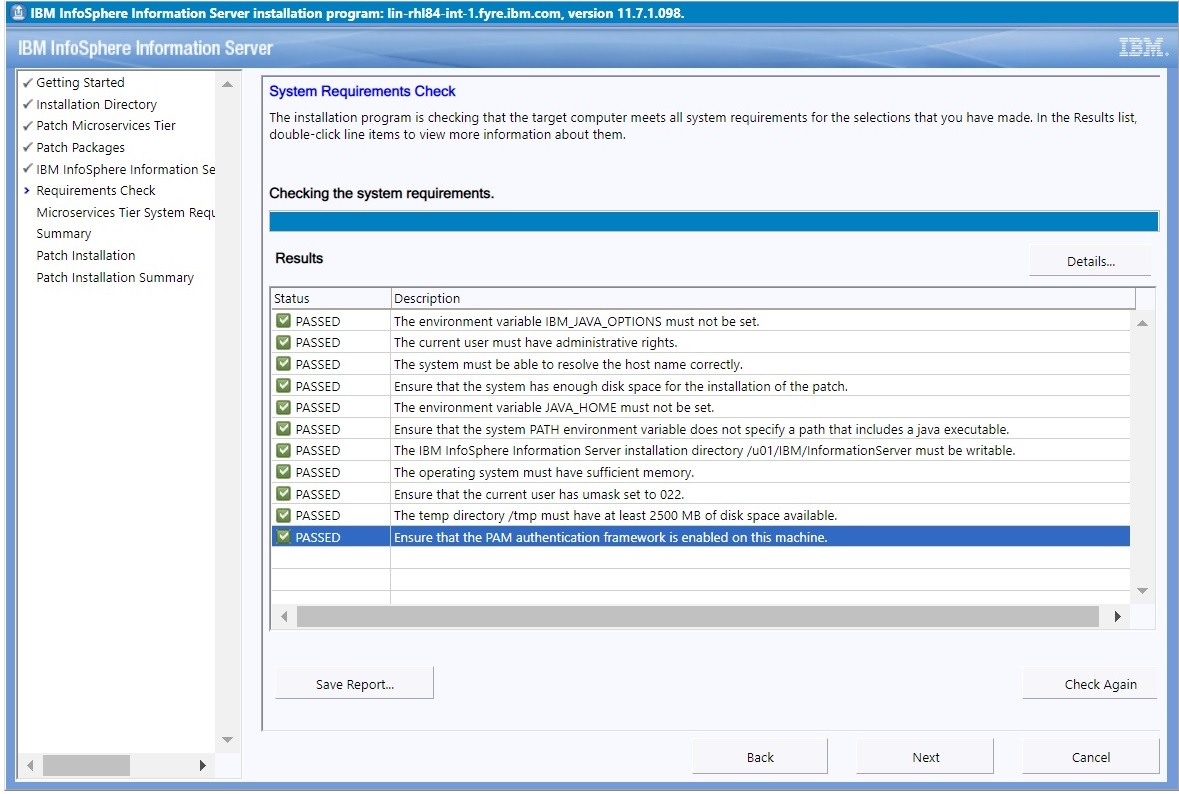
4.1.12) If you have a Microservices tier, examine the results from system requirement checks of the Microservices tier. If all is good, click Next.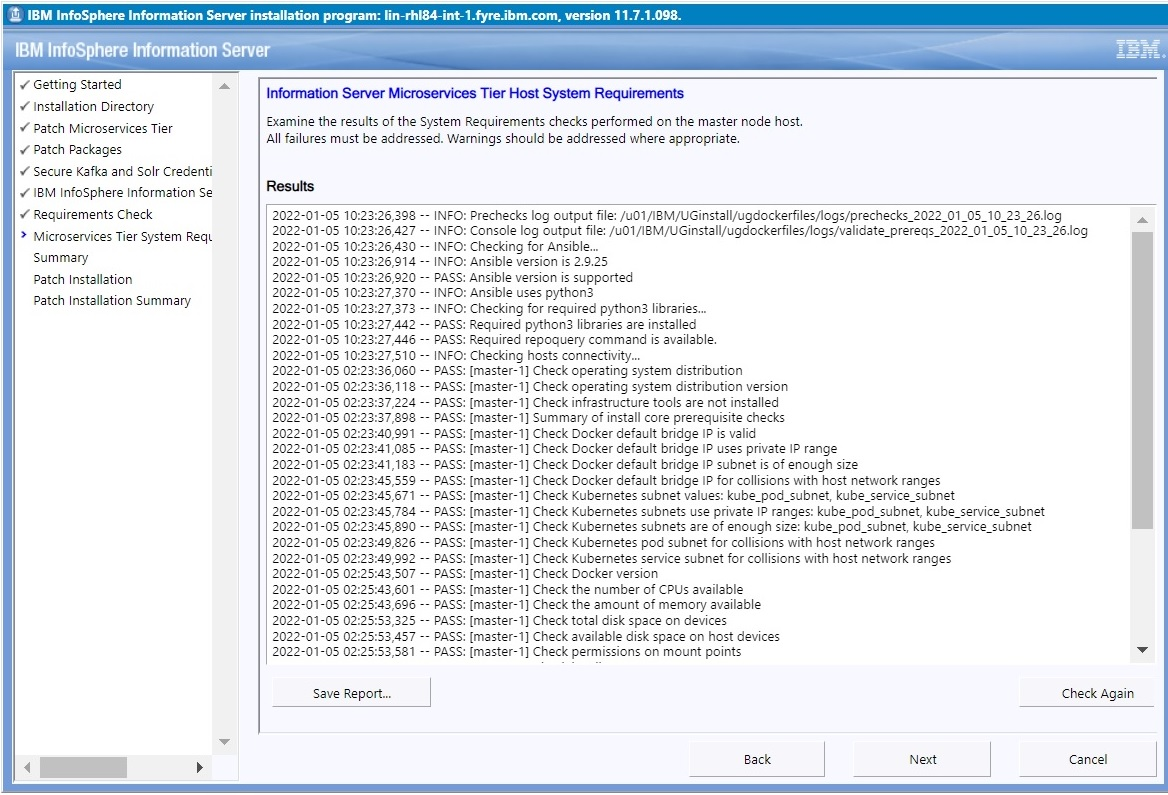
4.1.13) Review the Preinstallation Summary and click the Install button to start the installation.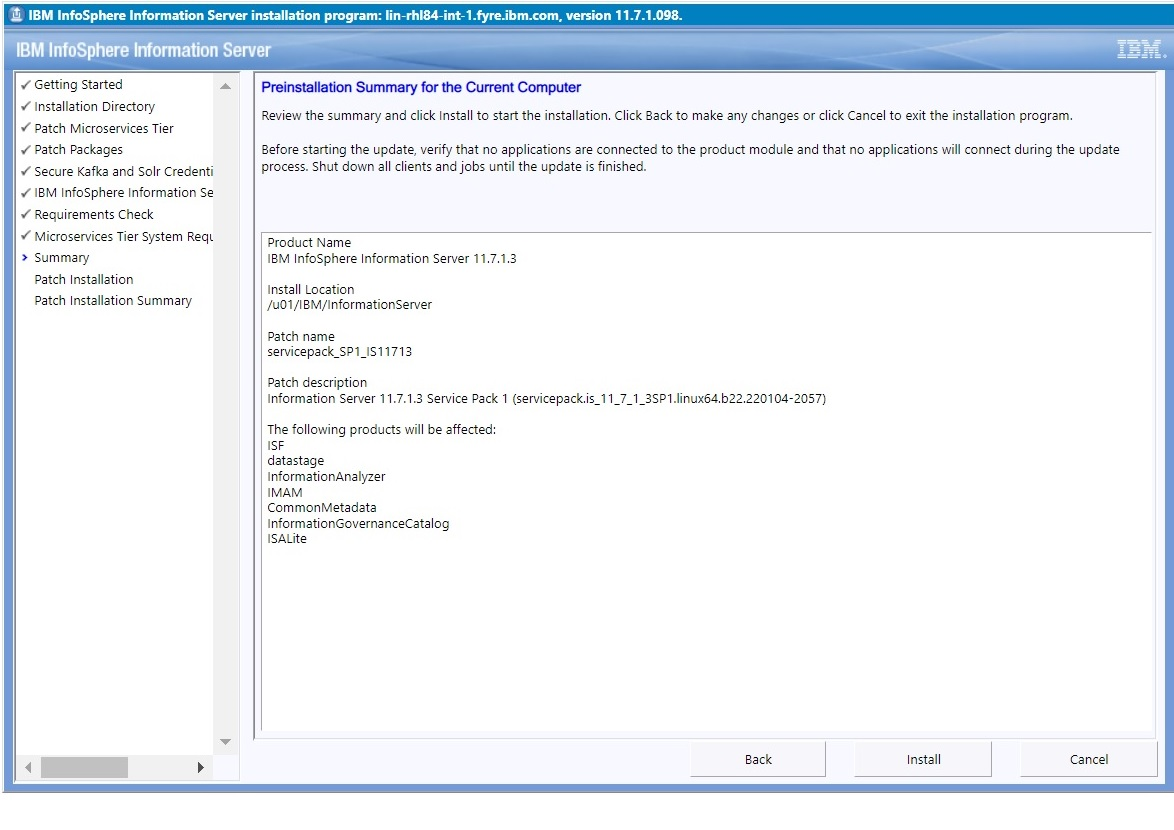
4.1.14) Click the Finish button after the installation completes.
4.1.15) Click “Advanced” followed by "Accept the Risk and Continue".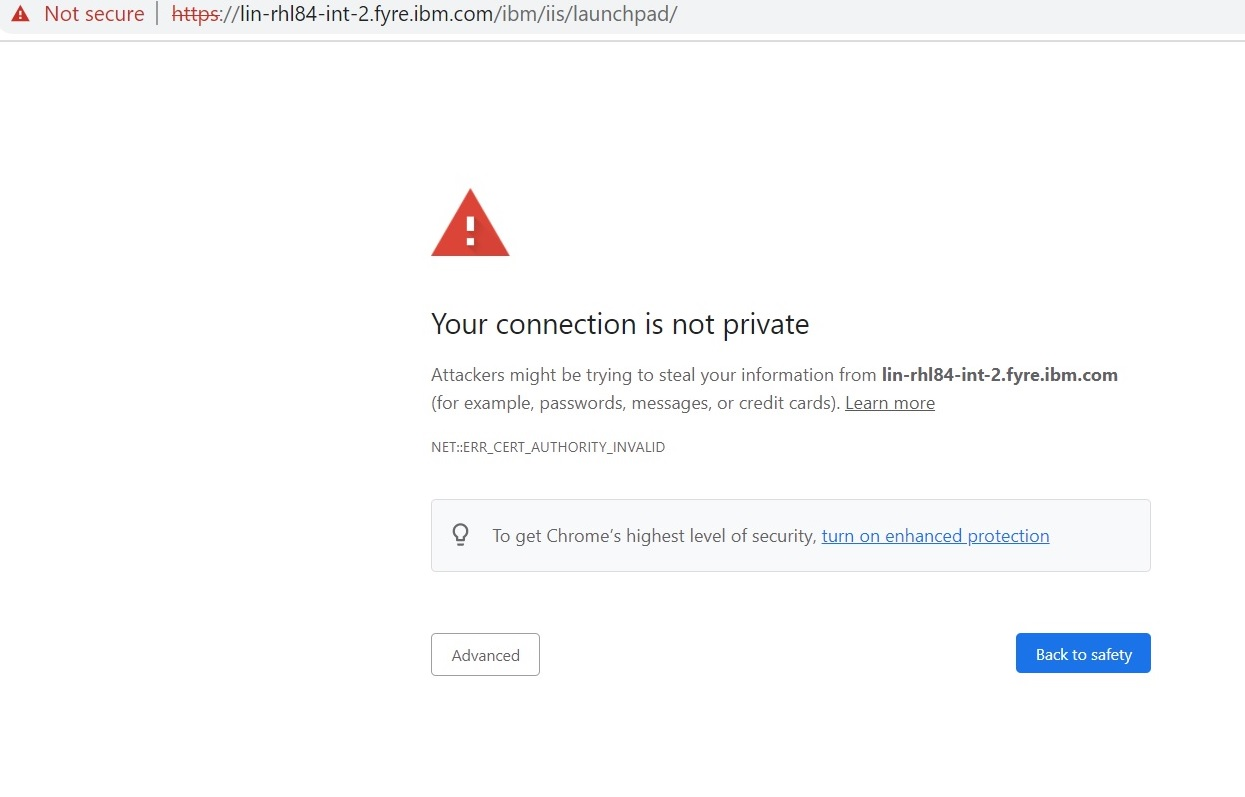
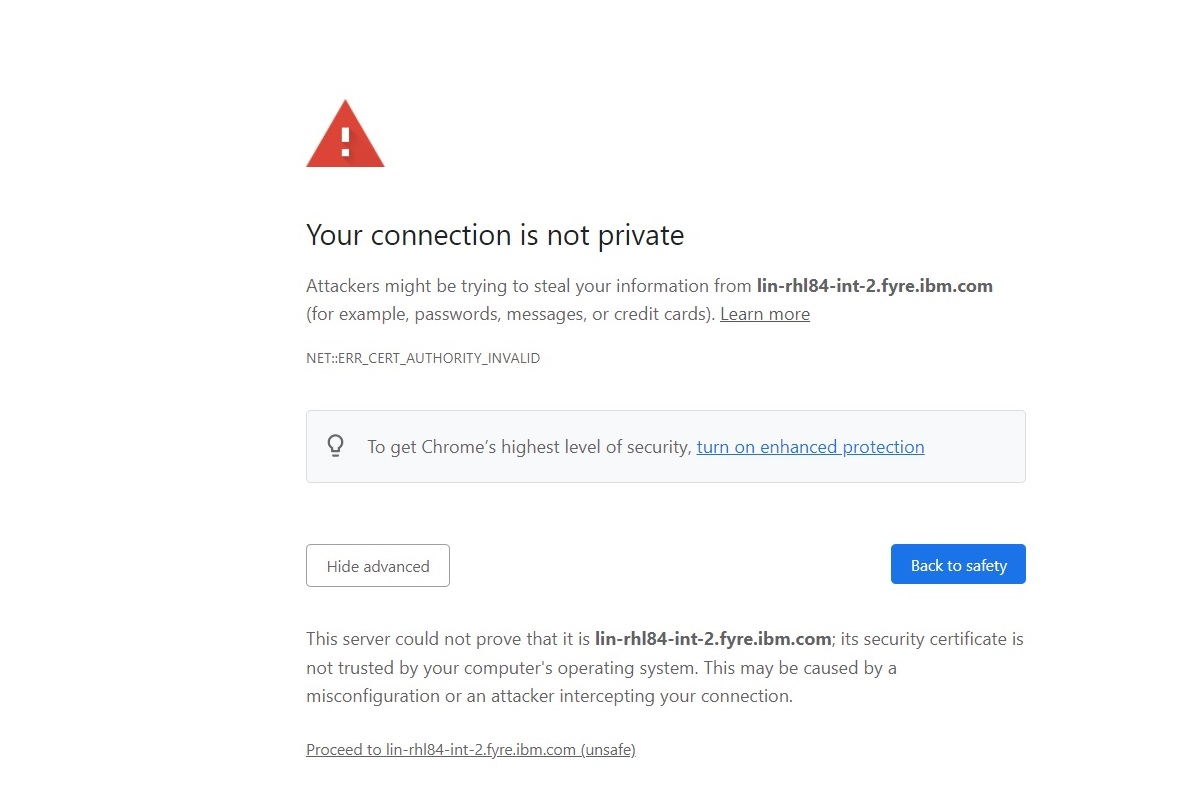
4.1.16) The Launchpad is displayed.
4.1.16.1) If you do not have a Microservices tier, the Information Server Launchpad is displayed.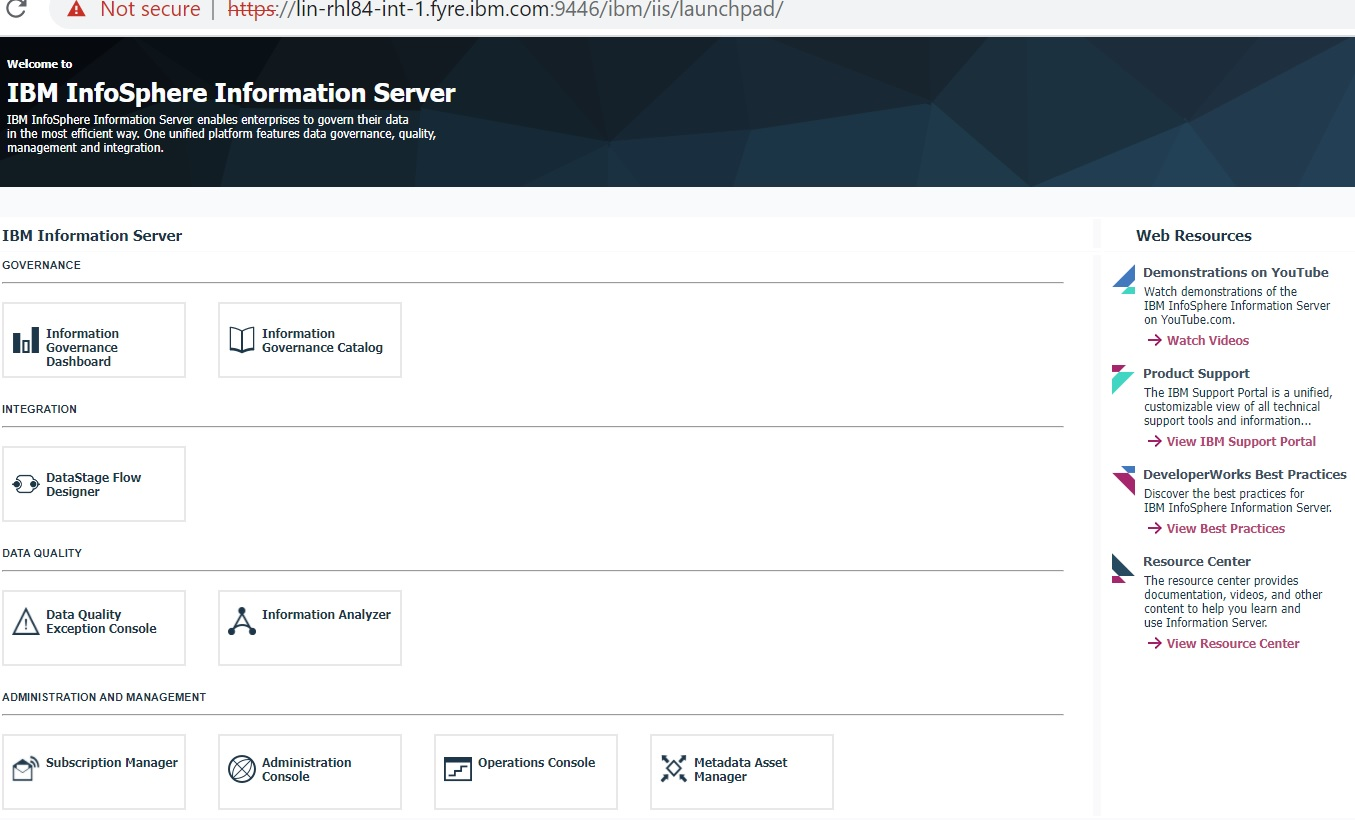
4.1.16.2) If you have a Microservices tier, the Information Server (Microservices) Launchpad is displayed.

4.2) Instructions for upgrading Information Server in Console mode of the Update Installer
1. The Microservices tier must be at version 11.7.1.3 before installation of Service Pack 4.
2. The validation checks performed by the Update Installer in Console mode are not as extensive as the checks performed when the Update Installer is in GUI mode.
4.2.1) Login to the Information Server host. Change directory to <IS_HOME>/Updates/bin
For example, cd /opt/IBM/InformationServer/Updates/bin
4.2.2) Verify that the Update Installer version is 11.7.1.105 or later:
./installUpdates -version
If you need to update the Update Installer, see step 3.1.
4.2.3) Run the Update Installer to upgrade Information Server.
For example,
installUpdates -i /opt/IBM/InformationServer/ -p /opt/Builds/ISPKG/<ispkg_file_name>.ispkg -verbose -console -properties <property_file_name>
where
<ispkg_file_name> is the ispkg file you downloaded from IBM Fix Central
For example, servicepack_11.7.1.3_SP4_linux64_11713.tar.gz
<property_file_name> is the name of the property file wherein you specify values for the various properties that control the upgrade of the Microservices tier.
Sample property file
The Update Installer prompts you for the Information Server administrator user ID and password, and the WebSphere Administrator user ID and password.
5) Post upgrade actions
a. kubectl edit Ingress iis-server
ingress.kubernetes.io/configuration-snippet: |
proxy_redirect "https://$host:<IIS services tier port>/" "https://$host/";
proxy_redirect "https://<Microservices tier short host name>:<IIS services tier port>" "https://<Microservices tier short host name>/";
proxy_redirect "https://<Microservices tier host name alias>:<IIS services tier port>" "https://<Microservices tier host name alias>/";
proxy_redirect "https://<Microservices tier IP address>:<IIS services tier port>" "https://<Microservices tier IP address>/";
a. kubectl edit Ingress iis-redirect
ingress.kubernetes.io/configuration-snippet: |
proxy_redirect "https://$host:<IIS services tier port>/" "https://<IIS services tier short host name>:<IIS services tier port>/";
proxy_redirect "https://<Microservices tier short host name>:<IIS services tier port>" "https://<IIS services tier short host name>:<IIS services tier port>/";
proxy_redirect "https://<Microservices tier host name alias>:<IIS services tier port>" "https://<IIS services tier host name alias>:<IIS services tier port>/";
proxy_redirect "https://<Microservices tier IP address>:<IIS services tier port>" "https://<IIS services tier IP address>:<IIS services tier port>/";
Ensure that the newly added proxy_redirect lines are properly aligned with the prior proxy_redirect line as consumption of the file contents is sensitive to the formatting.
kubectl delete pods -l app=ingress-nginx -n kube-system
kubectl get pods -l app=ingress-nginx -n kube-system
On the Information Server host:
1. Add a host alias property:
$ ./iisAdmin.sh -set -key com.ibm.iis.ug.host.aliases -value
<Microservices tier long host name>,<Microservices tier short host name>,<Microservices tier alias name>,<Microservices tier IP address>
$ ./iisAdmin.sh -d -key com.ibm.iis.ug.host.aliases
On the Browser host:
Add an entry in the hosts file
UNIX: /etc/hosts
Windows: <Drive>:\Windows\System32\drivers\etc\host on Windows)
with IP address, long host name, short host name, and alias name as follows:
<Microservices tier IP address> <Microservices tier long host name> <Microservices tier short host name> <Microservices tier alias name>
5.2) (Optional) Backup and purge the Backup folder within the Updates and _uninstall folders
Information Server saves prior versions of JAR files to facilitate patch rollbacks and uninstall of components:
a. In the Updates folder within your Information Server location, for each patch installed, a patch folder is created with the name of the patch. The patch folder contains copies of files that are replaced during the patch installation. The patch folder name is based on the name of the patch, which can be seen in the History section of your Version.xml. The files in this folder are used by the Update installer to roll back a patch installation; they are not needed while Information Server is used.
b. Each time the Update Installer is updated, the JAR files used by the Update Installer that are changed, are saved in a new lib.<timestamp> folder within the Updates folder.
c. The _uninstall folder contains files that are only used while Information Server components are uninstalled.
For Apache Log4j related patches, the prior vulnerable versions of Apache Log4j could be present within such folders.
If you want to remove such Apache Log4j files from the system, take a backup of such a folder, and then purge the folder.
An appropriate backup of the patch folder must be restored before any subsequent patch rollback attempt.
Likewise, an appropriate backup of the files in _uninstall must be restored before any subsequent uninstall action.
The service pack installation does not remove a log4j version 1.x JAR file on the services tier in <IIS_INSTALL_LOCATION>/wlp/usr/servers/mis/apps/brokers.war. You can use the following steps to replace the war file,
For example,
unzip servicepack_11.7.1.3_SP4_linux64_11713.ispkg
To delete mis server workarea,
Change directory to ISHOME\wlp\usr\servers\mis
rmdir /s workarea
If you have a client-only installation of Information Server 11.7.1.x, the service pack installation does not remove log4j version 1.x JAR files that were deployed for usage by the Salesforce Connector. Since the Salesforce Connector does not use this folder anymore, the folder can be deleted:
On the client-only installation machine:
5.5) Clean up shared open source deployment on the services tier when a Microservices tier is present
If you installed Information Server with a Microservices tier, and choose to not update the Microservices tier when an Information Server patch is applied, the Update Installer might install extra "shared-open-source" services on the services tier. Additionally, Information Server is configured to use these services instead of the services on the Microservices tier, and a shared-open-source directory is erroneously created on the services tier.
Follow these steps to reconfigure Information Server to again work with the Microservices tier:
a. Change directory to the shared-open-source directory on the services tier:
AIX or Linux: cd /opt/IBM/InformationServer/shared-open-source
Windows: cd C:\IBM\InformationServer\shared-open-source
b. Uninstall shared-open-source services on the services tier
AIX: bin/uninstall-aix-services.sh
Linux: bin/uninstall-linux-services.sh
Windows: bin\uninstall-windows-services.bat
c. Use the iisAdmin tool to set the zookeeper host and port in Information Server (specify your Microservices tier host name):
AIX and Linux: ./iisAdmin.sh -set -key com.ibm.iis.sdp.zookeeper.connect -value <masterNodeHost>:2181/kafka
Windows: iisAdmin.bat -set -key com.ibm.iis.sdp.zookeeper.connect -value <masterNodeHost>:2181/kafka
See iisAdmin command documentation for more information.
d. Delete the shared-open-source directory on the services tier:
AIX or Linux: rm -r /opt/IBM/InformationServer/shared-open-source
Windows: rmdir /s C:\IBM\InformationServer\shared-open-source
Change History:
27 April 2022: Initial publication
03 May 2022: Updates/backup and _uninstall/Backup folders must be purged; not the entire Updates & _uninstall folders
20 May 2022: Remove log4j JAR file from brokers.war
19 July 2022: Delete the Salesforce folder in Client-tier only installations as it might contain old log4j version.
Clarified that a patch folder is created in Updates location, not a folder named backup.
29 November 2022: Updated section 5.3 steps to clean up log4j 1.x in brokers.war
31 January 2023: Added section 5.5 for cleanup of extra "shared-open-source" services on the services tier.
Was this topic helpful?
Document Information
Modified date:
31 January 2023
UID
ibm16567279

